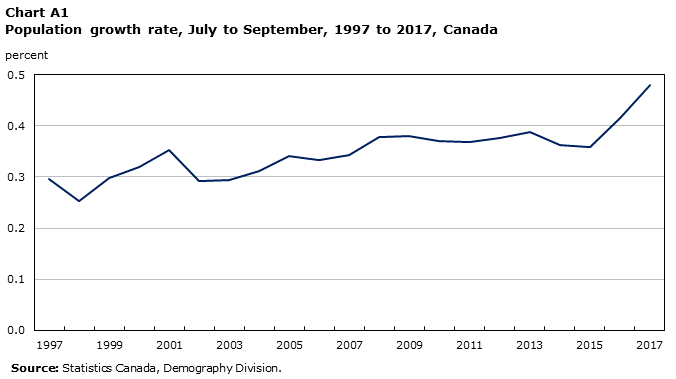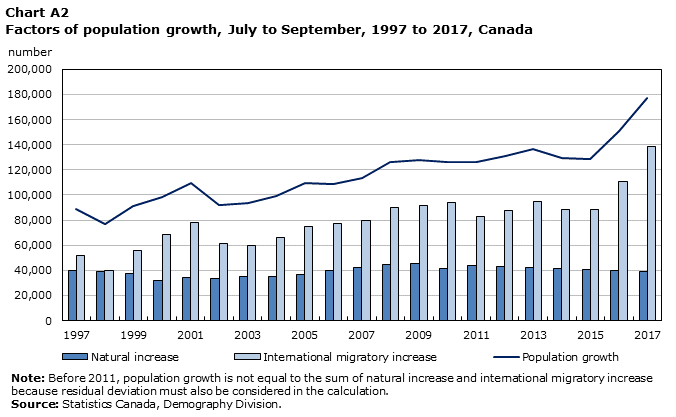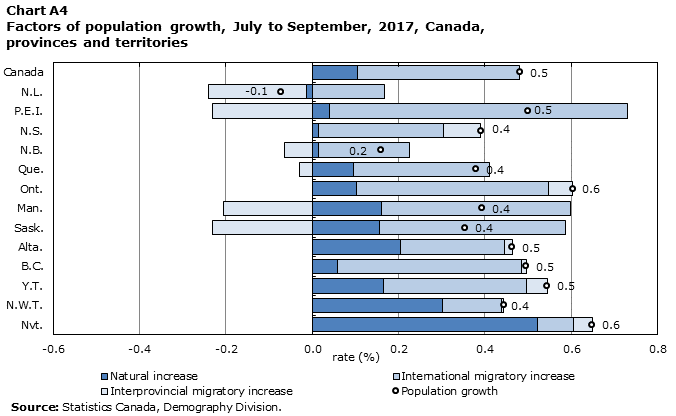Quarterly Demographic Estimates
July to September 2017
Archived Content
Information identified as archived is provided for reference, research or recordkeeping purposes. It is not subject to the Government of Canada Web Standards and has not been altered or updated since it was archived. Please "contact us" to request a format other than those available.
Highlights
- On October 1, 2017, Canada's population was estimated at 36,885,049.
- Between July 1 and October 1, 2017, Canada's population rose by 176,966 (+0.5%), the highest increase observed for a trimester since 1971.
- Canada's population growth in the third quarter of 2017 was largely due to international migration (+138,315), a level never seen since 1971.
- A major proportion of the international migration growth was attributable to an unprecedented rise in the number of non-permanent residents (+79,804).
- Ontario and Nunavut had the highest rates of population growth during this period (+0.6% each).
- Preliminary estimates for the last quarter indicate that Alberta recorded interprovincial migration gains of 743 people, following eight consecutive negative quarters, and a total increase of 0.5% (+19,905).
Analysis
Canada's population continues to grow at a steady pace
According to preliminary estimates, Canada's population was estimated at 36,885,049 on October 1, 2017, up 176,966 from July 1, 2017. This increase in absolute numbers was the highest recorded for any quarter since the beginning of the period covered by the current demographic accounting system (July 1971). In addition, Canada reached a summit in its quarterly demographic estimates with an increase of 0.5%. All quarters considered, it is the second time only that the country recorded such a level since July 1971, the first time being seen on the third quarter of 1988.

Data table for Chart A1
| year | percent |
|---|---|
| 1997 | 0.30 |
| 1998 | 0.25 |
| 1999 | 0.30 |
| 2000 | 0.32 |
| 2001 | 0.35 |
| 2002 | 0.29 |
| 2003 | 0.29 |
| 2004 | 0.31 |
| 2005 | 0.34 |
| 2006 | 0.33 |
| 2007 | 0.34 |
| 2008 | 0.38 |
| 2009 | 0.38 |
| 2010 | 0.37 |
| 2011 | 0.37 |
| 2012 | 0.38 |
| 2013 | 0.39 |
| 2014 | 0.36 |
| 2015 | 0.36 |
| 2016 | 0.42 |
| 2017 | 0.48 |
| Source: Statistics Canada, Demography Division. | |
International migration continues to account for most of the population growth
Population growth at the national level is based on two factors: natural increaseNote 1 and international migratory increase,Note 2 while provincial and territorial population estimates also factor in interprovincial migratory increase.
International migratory increase remained the main driver of the Canadian population growth, with an estimated increase of 138,315 between July 1 and September 30, 2017. This is the highest gain observed since the beginning of the period covered by the current demographic accounting system (July 1971). In Canada, the last quarter's increase was mainly attributable to an unprecedented gain in the number of non-permanent residents (+79,804),Note 3 a record for any quarter since July 1971. The main source of this increase was a growth in the number of study permit holders, as well as equal gains in the number of work permit holders and refugee claimants. Many of these refugee claimants were born in Haiti, especially those arriving in Quebec. In the third quarter of 2017, the number of non-permanent residents exceeded the number of immigrants admitted to Canada (+70,132)—a scenario rarely seen in the past. Nevertheless, the number of immigrants was the second highest for a third quarter in the past six years, after the third quarter of 2015 (+78,899). The components of net emigration (emigration, returning emigration and net temporary emigration) remained stable.
According to preliminary estimates, natural increase in the third quarter of 2017 was 38,651, or the difference between 103,730 births and 65,079 deaths. Natural increase fell below the 40,000 mark, a phenomenon not seen in a third quarter since 2005. Due to seasonality, the number of births in Canada is often highest between July and September (the summer months). Seasonality is also observed for deaths, the difference being that there are more deaths during the first quarter, i.e., from January to March (the winter months). In the coming years, natural increase is expected to decrease, mainly under the influence of the population ageing, which results in a growth of the number of deaths observed each year.

Data table for Chart A2
| year | Natural increase | International migratory increase | Population growth |
|---|---|---|---|
| number | |||
| 1997 | 39,814 | 51,541 | 88,842 |
| 1998 | 38,934 | 40,047 | 76,466 |
| 1999 | 37,567 | 55,769 | 90,820 |
| 2000 | 31,981 | 68,775 | 98,239 |
| 2001 | 33,964 | 77,695 | 109,434 |
| 2002 | 33,177 | 61,070 | 92,025 |
| 2003 | 35,445 | 59,998 | 93,221 |
| 2004 | 35,211 | 66,440 | 99,430 |
| 2005 | 36,917 | 75,175 | 109,869 |
| 2006 | 40,042 | 77,090 | 108,481 |
| 2007 | 42,397 | 79,403 | 113,148 |
| 2008 | 44,795 | 89,890 | 126,037 |
| 2009 | 45,301 | 91,491 | 128,143 |
| 2010 | 41,035 | 93,793 | 126,177 |
| 2011 | 43,828 | 82,719 | 126,547 |
| 2012 | 42,836 | 87,988 | 130,824 |
| 2013 | 41,836 | 94,903 | 136,739 |
| 2014 | 41,238 | 88,066 | 129,304 |
| 2015 | 40,495 | 88,303 | 128,798 |
| 2016 | 40,020 | 111,097 | 151,117 |
| 2017 | 38,651 | 138,315 | 176,966 |
|
Note: Before 2011, population growth is not equal to the sum of natural increase and international migratory increase because residual deviation must also be considered in the calculation. Source: Statistics Canada, Demography Division. |
|||
Population growth observed everywhere except in Newfoundland and Labrador
During the third quarter of 2017, population growth was positive in all provinces and territories, except Newfoundland and Labrador, where the population growth rate was -0.1%.Note 4 Nunavut and Ontario had the highest population growth rate (+0.6% each) in Canada. Elsewhere, the population growth rate reached 0.5% in Prince Edward Island, Alberta, British Columbia and Yukon. Population growth in these provinces and territory was equal to the Canadian rate (+0.5%), of which 19,905 more people in Alberta.
Compared with the same period last year, population growth rate was up in Nova Scotia, Quebec, Alberta and the territories (Chart A3). In the Northwest Territories, growth rates shifted from negative to positive, while the opposite was observed in the Newfoundland and Labrador (although rates approached zero in the latest).

Data table for Chart A3
| Provinces and territories | 2016 | 2017 | 2016 (Canada) | 2017 (Canada) |
|---|---|---|---|---|
| percent | ||||
| N.L. | 0.1 | -0.1 | 0.4 | 0.5 |
| P.E.I. | 0.4 | 0.5 | 0.4 | 0.5 |
| N.S. | 0.3 | 0.4 | 0.4 | 0.5 |
| N.B. | 0.2 | 0.2 | 0.4 | 0.5 |
| Que. | 0.3 | 0.4 | 0.4 | 0.5 |
| Ont. | 0.6 | 0.6 | 0.4 | 0.5 |
| Man. | 0.4 | 0.4 | 0.4 | 0.5 |
| Sask. | 0.4 | 0.4 | 0.4 | 0.5 |
| Alta. | 0.3 | 0.5 | 0.4 | 0.5 |
| B.C. | 0.4 | 0.5 | 0.4 | 0.5 |
| Y.T. | 0.2 | 0.5 | 0.4 | 0.5 |
| N.W.T. | -0.5 | 0.4 | 0.4 | 0.5 |
| Nvt. | 0.3 | 0.6 | 0.4 | 0.5 |
| Source: Statistics Canada, Demography Division. | ||||
International migration is the main driver of growth in almost all provinces
During the third quarter of 2017, international migratory increase was the main driver of demographic growth in almost all provinces and in Yukon. In fact, six provinces and one territory posted unprecedented gains for a third quarter. In Alberta, however, natural increase and international migratory increase accounted for the population growth in similar proportions. The Northwest Territories and Nunavut continued to post the highest rates of natural increase, which accounted for 68% and 81% of their demographic growth respectively. Statistics show that fertility in these two territories is higher than the rest of Canada.Note 5
In most provinces, an increase in the number of non-permanent residents was behind the rise in international migratory increase. Quebec recorded a gain of 14,601 non-permanent residents,Note 6 a major increase over the third quarter of 2016 (+5,902). In addition, Ontario posted a 39,862 increase in non-permanent residents, compared with 30,821 in the same quarter one year earlier. In British Columbia, the number of non-permanent residents rose 14,702, compared with 9,107 during the same quarter last year.

Data table for Chart A4
| Provinces and territories | Natural increase | International migratory increase | Interprovincial migratory increase | Population growth |
|---|---|---|---|---|
| rate (%) | ||||
| Canada | 0.11 | 0.38 | 0.00 | 0.48 |
| N.L. | -0.01 | 0.17 | -0.23 | -0.07 |
| P.E.I. | 0.04 | 0.69 | -0.23 | 0.50 |
| N.S. | 0.01 | 0.29 | 0.09 | 0.39 |
| N.B. | 0.02 | 0.21 | -0.06 | 0.16 |
| Que. | 0.09 | 0.31 | -0.03 | 0.38 |
| Ont. | 0.10 | 0.45 | 0.05 | 0.60 |
| Man. | 0.16 | 0.44 | -0.20 | 0.39 |
| Sask. | 0.16 | 0.43 | -0.23 | 0.35 |
| Alta. | 0.20 | 0.24 | 0.02 | 0.46 |
| B.C. | 0.06 | 0.42 | 0.01 | 0.50 |
| Y.T. | 0.17 | 0.33 | 0.05 | 0.54 |
| N.W.T. | 0.30 | 0.14 | 0.00 | 0.44 |
| Nvt. | 0.52 | 0.08 | 0.04 | 0.65 |
| Source: Statistics Canada, Demography Division. | ||||
| Population | Population growth for the third quarter | ||||
|---|---|---|---|---|---|
| 2016 | 2017 | ||||
| number | rate (%) | number | rate (%) | ||
| Canada | 36,885,049 | 151,117 | 0.4 | 176,966 | 0.5 |
| N.L. | 528,430 | 313 | 0.1 | -387 | -0.1 |
| P.E.I. | 152,784 | 627 | 0.4 | 763 | 0.5 |
| N.S. | 957,600 | 2,727 | 0.3 | 3,731 | 0.4 |
| N.B. | 760,868 | 1,222 | 0.2 | 1,213 | 0.2 |
| Que. | 8,425,996 | 22,720 | 0.3 | 31,962 | 0.4 |
| Ont. | 14,279,196 | 77,338 | 0.6 | 85,812 | 0.6 |
| Man. | 1,343,371 | 5,435 | 0.4 | 5,262 | 0.4 |
| Sask. | 1,168,057 | 5,002 | 0.4 | 4,132 | 0.4 |
| Alta. | 4,306,039 | 14,440 | 0.3 | 19,905 | 0.5 |
| B.C. | 4,841,078 | 21,305 | 0.4 | 23,918 | 0.5 |
| Y.T. | 38,669 | 84 | 0.2 | 210 | 0.5 |
| N.W.T. | 44,718 | -211 | -0.5 | 198 | 0.4 |
| Nvt. | 38,243 | 115 | 0.3 | 247 | 0.6 |
| Source: Statistics Canada, Demography Division. | |||||
According to preliminary demographic estimates, interprovincial migratory increase was up in Alberta (+743), following eight consecutive quarters of interprovincial migratory losses (not shown). Alberta has not recorded this many consecutive quarters with negative results since the second half of the 1980s, when it saw ten consecutive quarters of interprovincial migration losses. In its exchanges with other provinces and territories, Alberta's migratory increases came mainly from Saskatchewan, Manitoba and Newfoundland and Labrador, though the gain was partially offset by losses to Ontario. Ontario (+7,807) continued to post the strongest interprovincial migratory increase in absolute terms. Although the influx came from most provinces, the highest proportion was from Quebec, Manitoba and Alberta. Nova Scotia ranked second for interprovincial gains with 827 people, with migrants coming primarily from Newfoundland and Labrador, Quebec, Ontario and British Columbia. British Columbia also recorded interprovincial migration gains of 543 people.
In Quebec, interprovincial migratory growth remained negative (-2,479). In fact, the last time Quebec experienced an interprovincial migration balance above zero was the fourth quarter of 2009 (+15). The interprovincial migration balance was also negative for Saskatchewan (-2,693) and Manitoba (-2,744), with significant outflows to Ontario, Alberta and British Columbia.

Data table for Chart A5
| Provinces and territories | In-migrants | Out-migrants | Net |
|---|---|---|---|
| number | |||
| N.L. | 1,472 | -2,669 | -1,197 |
| P.E.I. | 787 | -1,138 | -351 |
| N.S. | 4,748 | -3,921 | 827 |
| N.B. | 3,055 | -3,548 | -493 |
| Que. | 6,999 | -9,478 | -2,479 |
| Ont. | 24,227 | -16,420 | 7,807 |
| Man. | 2,962 | -5,706 | -2,744 |
| Sask. | 3,544 | -6,237 | -2,693 |
| Alta. | 17,775 | -17,032 | 743 |
| B.C. | 14,272 | -13,729 | 543 |
| Y.T. | 301 | -282 | 19 |
| N.W.T. | 565 | -563 | 2 |
| Nvt. | 257 | -241 | 16 |
| Source: Statistics Canada, Demography Division. | |||
- Date modified:

